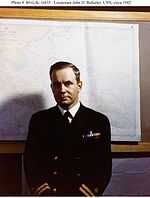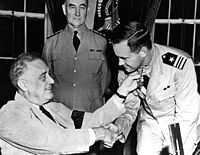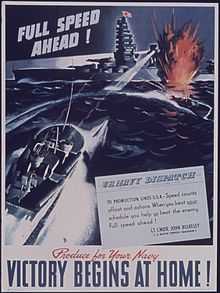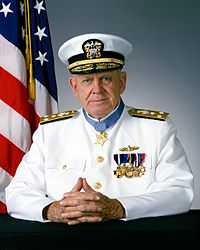John D. Bulkeley
| John D. Bulkeley | |
|---|---|
|
Vice Admiral John D. Bulkeley | |
| Nickname(s) | "Sea Wolf"[1] |
| Born |
August 19, 1911 New York City, New York |
| Died |
April 6, 1996 (aged 84) Silver Spring, Maryland |
| Place of burial | Arlington National Cemetery |
| Allegiance |
|
| Service/branch |
|
| Years of service | 1933–1988 |
| Rank |
|
| Battles/wars |
|
| Awards |
Medal of Honor Navy Cross Distinguished Service Cross (2) Navy Distinguished Service Medal Silver Star (2) Legion of Merit (2) Purple Heart (2) Combat Action Ribbon (3) Croix de Guerre (France) Distinguished Conduct Star (Phil.) |
John Duncan Bulkeley (August 19, 1911 – April 6, 1996) was a Vice Admiral in United States Navy and was one of the most decorated naval officers. Bulkeley received the Medal of Honor for actions in the Pacific Theater during World War II. He was also the PT boat skipper who evacuated General Douglas MacArthur from Corregidor in the Philippines and commanded at the Battle of La Ciotat. The Navy named an Arleigh Burke-class guided missile destroyer after him: USS Bulkeley (DDG-84), commissioned in 2001.
Early life and career

Bulkeley was born in New York City and grew up on a farm in Hackettstown, New Jersey where he graduated from Hackettstown High School.[2] Unable to gain an appointment to Annapolis from his home state of New Jersey, he gained an appointment from the state of Texas.[3] Due to budget constraints, only the upper half of the 1933 Academy class received a commission upon graduation. John Bulkeley, noted early on for his intense interest in engineering, joined the Army Air Corps. Like the flying machines of the day, he landed hard more than once. After a year, and because the President and Congress permitted additional commissions in the Navy (as a government plan for additional jobs), Bulkeley gave up flying for the deck of a cruiser, the USS Indianapolis (CA-35), as a commissioned officer in the Navy.
Bulkeley charted an interesting course in his early years and was recognized early on by the Navy's leadership. As a new ensign in the mid-1930s, he took the initiative to remove the Japanese ambassador's briefcase from a stateroom aboard a Washington-bound steamer, delivering it to Naval Intelligence a short swim later. This bold feat, the first of many in his life, did not earn him any medals, but it did get him a swift one-way ticket out of the country and a new assignment as Chief Engineer of a coal-burning gunboat, the USS Sacramento (PG-19), also known in those parts as "The Galloping Ghost of the China Coast". There he met Alice Wood, a young, attractive English girl, at a dinner party aboard HMS Diana (H49). In China, they witnessed the invasion of Swatow and Shanghai by Japanese troops and the bombing of USS Panay (PR-5), the first US Navy ship sunk in World War II.
World War II

At the dawn of World War II, Bulkeley was a lieutenant in command of Motor Torpedo Boat Squadron Three, a Philippine-based detachment of six motor torpedo boats. He hit his stride as a daring, resourceful and courageous leader. He picked up General Douglas MacArthur, his family, and his immediate staff, who had been ordered to flee the Philippines, and took them aboard PT 41 and other 77-foot (23 m) motor torpedo boats through over 600 nautical miles (1,000 km) of open ocean. On arriving at Mindanao, MacArthur said, "You have taken me out of the jaws of death. I shall never forget it." Bulkeley earned many of his array of decorations while in command of that squadron and a subsequent one.
In 1944, he took part in the Normandy invasion. Bulkeley led torpedo boats and minesweepers in clearing the lanes to Utah Beach,[4] keeping German E-boats from attacking the landing ships along the Mason Line, and picking up wounded sailors from the sinking minesweeper USS Tide (AM-125), destroyer escort USS Rich (DE-695), and destroyer USS Corry (DD-463). As invasion operations wound down, he received command of his first large ship, the destroyer USS Endicott (DD-495). One month after D-Day, he came to the aid of two British gunboats under attack by two German corvettes. Charging in with only one gun working, he engaged both enemy vessels at point-blank range, sinking both. When asked, he explained, "What else could I do? You engage, you fight, you win. That is the reputation of our Navy, then and in the future."
Cold War
During the Korean War in 1952, Bulkeley commanded Destroyer Division 132. After the war, he was Chief of Staff for Cruiser Division Five.[5]
In the early 1960s, Bulkeley commanded Clarksville Base, Tennessee, then a tri-service command under the aegis of the Defense Atomic Support Agency. Having lost none of his wartime daring, Bulkeley was known to test the alertness of the Marines guarding the base by donning a ninja suit, blackening his face and endeavoring to penetrate the classified area after dark without detection. This was a dangerous endeavor, as the Marines carried loaded weapons. Ever popular with his men, who both respected and admired him, Bulkeley could be seen driving around the base in his fire-engine red Triumph TR3 sports car with a large silver PT boat as a hood ornament.
Promoted to Rear Admiral by President John F. Kennedy, who commanded PT-109 during World War II, Bulkeley was dispatched to command the Guantanamo Bay Naval Base in Cuba,[4] where he met Cuba's threat to sever water supplies in response to the Bay of Pigs invasion and other assaults by ordering the installation of desalinization equipment to make the base self-sufficient.
Last years
Bulkeley retired from active duty in 1975. However, he was recalled to active duty in a retired-retained status in order to serve as the commander of the Navy's Board of Inspection and Survey (INSURV) which conducts inspections and surveys of U.S. naval vessels before their commissioning and deployment.[6] Bulkeley retired from the Navy in 1988, after 55 years of service.[4][7]
On April 6, 1996, Bulkeley died at his home in Silver Spring, Maryland, at age 84.[4] Admiral Bulkeley was buried with full military honors at Arlington National Cemetery.[1]
Awards and decorations
Military decorations: the Medal of Honor, the Navy Cross, two Distinguished Service Crosses, two Navy Distinguished Service Medals, two Silver Stars, two Legion of Merits with Combat V, two Purple Hearts, three Combat Action Ribbons, the French Croix de Guerre and the Distinguished Conduct Star.[1]
| ||||||||||||||||||||||||||||||||||||||||||||
Medal of Honor citation

Bulkeley's Medal of Honor citation reads:
For extraordinary heroism, distinguished service, and conspicuous gallantry above and beyond the call of duty as commander of Motor Torpedo Boat Squadron 3, in Philippine waters during the period 7 December 1941 to 10 April 1942. The remarkable achievement of LCDR Bulkeley's command in damaging or destroying a notable number of Japanese enemy planes, surface combatant and merchant ships, and in dispersing landing parties and land-based enemy forces during the 4 months and 8 days of operation without benefit of repairs, overhaul, or maintenance facilities for his squadron, is believed to be without precedent in this type of warfare. His dynamic forcefulness and daring in offensive action, his brilliantly planned and skillfully executed attacks, supplemented by a unique resourcefulness and ingenuity, characterize him as an outstanding leader of men and a gallant and intrepid seaman. These qualities coupled with a complete disregard for his own personal safety reflect great credit upon him and the Naval Service.[8]
Legacy
Route 57 in Mansfield Township, Warren County, New Jersey, is named the "Admiral John D. Bulkeley Memorial Highway" in his honor.[9] In addition, the USN destroyer USS Bulkeley (DDG-84), commissioned in 2001, is named after him.
Bulkeley in the movies
Robert Montgomery played motor torpedo boat squadron commander LT Brickley, based on Bulkeley, in the 1945 movie They Were Expendable,[1] John Ford, assisted by Montgomery, directed. The cast also includes John Wayne, Ward Bond, and Donna Reed.
See also
Notes
- ↑ 1.0 1.1 1.2 1.3 Arlington National Cemetery profile.
- ↑ Bowman, Tom. "'Bold buckaroo' motivates Mid Medal of Honor winner, rescuer of MacArthur meets young 'shipmate'", The Baltimore Sun, November 13, 1993. Accessed October 4, 2011. "She asked her teachers and her principal about this man, John D. Bulkeley. And she read "Sea Wolf," detailing the World War II exploits that helped make him one of the most decorated fighting men in U.S. history.After a 59-year career in the Navy, the retired admiral performed one final -- though unwitting -- duty: Serving as the inspiration for his fellow Hackettstown High graduate to enter the Naval Academy."
- ↑ "Vice Admiral John D. Bulkeley, USN", INSURV.
- ↑ 4.0 4.1 4.2 4.3 Swarns, " Vice Adm. John D. Bulkeley, 84, Hero of D-Day and Philippines", New York Times, 1996.
- ↑ "Vice Admiral John D. Bulkeley, 1941–1996". Surface Navy Association Hall of Fame. February 27, 2004. Retrieved 2007-10-19.
- ↑ Among the ships Bulkeley inspected was USS Samuel B. Roberts (FFG-58) in 1986; his sea trials report calls the guided missile frigate "one of the cleanest [of its class] that the Board has seen." No Higher Honor: FFG 58 Leaves Bath Iron Works For Sea Trials.
- ↑ "Vice Admiral John D. Bulkeley, USN (Ret) "An outstanding leader of men and a galant and intrepid seaman"". DefenseLINK. U.S. Department of Defense. April 6, 1996. Retrieved 2007-10-19.
- ↑ "Medal of Honor recipients, WWII, A–F". U.S. Army. Retrieved 2004-09-11.
- ↑ "Route 57 straight line diagram" (PDF). New Jersey Department of Transportation. Retrieved 2009-07-13.
References
- "Vice Admiral John D. Bulkeley, USN". INSURV, United States Navy. Archived from the original on 2004-08-21. Retrieved 2004-09-11.
- Swarns, Rachel L. (April 8, 1996). "Vice Adm. John D. Bulkeley, 84, Hero of D-Day and Philippines". New York Times. Retrieved 2007-10-19.
- "Medal of Honor recipients, WWII, A–F". U.S. Army. Retrieved 2004-09-11.
- "John Duncan Bulkeley, Vice Admiral, United States Navy". Arlington National Cemetery website. Retrieved 2005-06-27.
- "Vice Admiral John D. Bulkeley, USN (Ret) "An outstanding leader of men and a galant and intrepid seaman"". DefenseLINK. U.S. Department of Defense. April 6, 1996. Retrieved 2007-10-19.
- "Vice Admiral John D. Bulkeley, 1941–1996". Surface Navy Association Hall of Fame. February 27, 2004. Retrieved 2007-10-19.
- Sea Wolf, A Biography of John D. Bulkeley, USN by William B. Breuer, published by Presidio Press, 31 Pamaron Way, Novato, CA 94949 ISBN 0-89141-335-9
External links
| Wikimedia Commons has media related to John D. Bulkeley. |
- "Papers of John D. Bulkeley, Dwight D. Eisenhower Presidential Library". Retrieved September 29, 2010.
- "John Bulkeley". Claim to Fame: World War II Congressional Medal of Honor Recipient. Find a Grave. Retrieved December 5, 2010.
|

